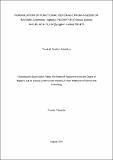Formulation of functional beverage from a blend of baobab (adansonia-digitata), pineapple (comosus ananas) and black-plum (syzygium cumini) fruits
Abstract
Several under-utilized tropical fruits have essential micronutrients and phytochemical
composition with the potential to contribute to the nutrition of people in many poor
communities where they are grown. This study was carried out to investigate the use of juice
blends of baobab, pineapple, and black-plum fruits as functional beverages for human benefits.
To understand potential consumers’ unmet need for healthy drinks, a knowledge, attitude, and
consumption pattern (KAP) survey was conducted and it was revealed that most (85%) of the
151 participants seek affordable healthy beverages from a blend of juices with moderate
sweetness and flavor. Pasteurized juice blends of baobab, pineapple, and black-plum fruits
were analyzed for physicochemical, antioxidant, sensory properties, mineral compositions, and
storage stability at 4°C for 4 weeks. The results showed that the vitamin C contents of
individual juices synergistically contributed to the high values observed in the blends (317.45-
414.51 mg/L). Juice blends of baobab, pineapple, and black-plum fruits are good sources of
calcium (57-153 mg/L), magnesium (71-130 mg/L), and antioxidants (ascorbic acid, total
polyphenol contents (65-104 mg GAE/100 mL), scavenging ability (105.97-359.71 µmol
TE/100 mL), and reducing potential (1376-1829 µMFe2+ L) the consumption of which can
promote human health. Physicochemical parameters of juice blends were stable at refrigeration
temperature (4°C) in the first two weeks; however, color change was observed towards the end
of the fourth storage week. The formulated ready-to-drink (RTD) beverages compared well
with a known market sample for sensory parameters with improved taste and consumer
acceptability and showed good antioxidant potential although there was a relative decrease in
vitamin C content during storage at both refrigeration and ambient temperatures. These
findings reveal that baobab fruit pulp, pineapple, and back-plum fruits can be major ingredients
in producing an antioxidant-rich functional beverage that meets the preferences of consumers.

